The Aberdeen Maternity and Neonatal Databank (AMND) was initiated in in 1950, originally as a resource for the study of the physiology, pathology and sociology of pregnancy. Latterly the application of AMND has extended significantly to include linkage with other health and social care records as well as intergenerational and family linkages. From the year 1950 to 2017, this unique database has recorded all the obstetric and fertility-related events occurring in women residing in Aberdeen, Scotland, UK with over 200,000 births recorded.
The Databank has been used for numerous research-related projects, ranging from epidemiological studies within Aberdeen to collaborative work with other units worldwide, generating around 200 publications to date - see our publications for details. More details on the information available and how the data can be accessed are given below.
AMND was started by Professor Sir Dugald Baird in 1950 in collaboration with the MRC Medical Sociology Unit
AMND records every pregnancy event occurring in in Aberdeen Maternity Hospital from 1950 to 2017. It can be linked with data from 2017 onwards.
AMND has intergenerational data on more than 7,600 grandmother-mother-granddaughter trios and more than 180 great grandmothers
All requests for access must be made through the AMND Steering Committee in order to ensure that the proposed use of the data conforms to accepted scientific standards
- History
-
The Aberdeen Maternity and Neonatal Databank was initiated in the Department of Obstetrics and Gynaecology by the late Professor Sir Dugald Baird, in 1950, in collaboration with the Medical Research Council (MRC) Medical Sociology Unit, as a resource for the study of physiology, pathology and sociology of pregnancy. From 1950 to 2017 this unique database links all the obstetric and fertility-related events occurring to women from a defined population.
Initially the data was held on punched cards, but by 1986 it was redeveloped onto a SIR database. This database now holds data for all Aberdeen City births from 1950 to 2017, with the MRC Medical Sociology Unit retaining responsibility for data relating to the period 1949 to1983 inclusive and the University of Aberdeen maintaining and controlling the data thereafter.
From 2017 onwards, data are collected via an electronic maternity records system but can be linked to AMND data. Two separate data request processes are required to obtain data from both datasets.

- Features
-
The Databank has been used for a number of research related projects - ranging from epidemiological studies within Aberdeen to collaborative work with other units world-wide, where anonymous extracts of the data are provided.
The Databank has a number of unique and special features which make it a particularly valuable resource for research purposes:
- Total Population
All reproductive events to women resident in a defined geographical area with a relatively stable population are included.
A tracing exercise using the Community Health Index (CHI) register in Scotland revealed that only 3.8% of those who gave birth in Aberdeen Maternity Hospital and consequently had a record in the AMND had migrated out of this geographical region. - All Fertility Related Events
All obstetric and fertility related gynaecological events, e.g., sterilisation, early pregnancies etc. are included in the Databank. This feature greatly enhances the quality of epidemiological and demographic data.
- Original Records (Hard copy)
The original Maternity case records are available for the whole period. Additional data items can thus be added to the Databank for selected cases and validity of data can be checked systematically.
- Duration
Data collection has been continuous between 1950 and 2017, allowing study of secular change, and identification of considerable numbers of intergenerational, sibling and twin pairs for the study of genetic and environmental influences upon reproductive performance.
- High Quality and Consistent Data
Stringent and consistent criteria have been used for the coding of gestation length, birthweight, pregnancy complications and cause of perinatal death by trained coding staff. When metrication was introduced for recording of height, birthweight etc., the earlier records were all converted.
- Multiple Pregnancies
Zygosity has been determined for the majority of twin pairs from 1968 onwards. This is also available for surviving twins born between 1960 and 1964.
- Record Linkage
Computerisation allows relatively easy identification of complete reproductive histories not only of individual women but also of families. Using this information intergenerational analysis can be performed.
- Extensive Social Data
An unusual amount of social data is available for most years including occupational for women, husbands or partners, grandfathers, duration of education and lifestyle factors such as smoking.
- Total Population
- Contents
-
It is virtually impossible to list all the variables that are recorded in a large database such as the AMND. A selection of commonly requested variables is given below. If a particular variable is required but does not appear below, it is best to ask - chances are it will be there (at least for some of the years!)
Explanation of Some Data Items Held
*indicates mandatory records
* MOTHER: This record contains the static information for each patient - Unitno
- Maiden Name/Forename
- Mother's Maiden Name
- Date, Place of Birth and Race
- Father's Social Class
- Current Parity
- Total No Pregnancies & Births
- Date of Last Event
- Sex & Zygosity of Twin if Applicable
- Blood Group
- Height & Height Classification
- CHI Number
* PREGNANCY: Details of the first ante-natal booking visit including some of the static items corresponding to the pregnancy - Unitno
- Pregnancy number
- Date of Booking
- Obstetrician ID Number
- Parity
- Patient Surname & Marital Status
- Patient Address & Postcode
- Date of Current Marriage
- Date of Last Menstrual Period
- Complications of pregnancy like preeclampsia, antepartum haemorrhage, premature rupture of membranes
- Pill Withdrawal Bleeding Experienced
- Gestation Period at Birth
- Menstrual Cycle
- Smoking Habit
- Pregnancy Counselling
- Ovulation Induction
- Husband/Father's Date of Birth, Race & Social Class
- Deprivation Category
- Patient's Social Class
- Patient's Social Class prior to Marriage
* BIRTH: Summary of labour and birth including date and time of the stages of labour either spontaneous or induced - Unitno
- Pregno
- Date & Time of Membrane Rupture
- Type of Membrane Rupture
- Date & Time of each Stage of Birth
- Type of Perineal Wound
- Type of Placenta Delivery
- Blood Loss at Birth
- Placental Weight
- Stage 3 Drugs Administered
- Age at Birth
- Number of Babies with Outcome
- Date of Discharge
- Duration between Birth Stages
- Labour Type- whether spontaneous, induced or elective caesarean section
- Singleton Birth (Yes/No)
* BABY: Details for Each Baby including Type of Birth & Outcome - Unitno
- Pregno
- Baby's Unit Number
- Number of Babies born for the Pregnancy
- Birth Order if Applicable
- Date of Birth & Time
- Type of Birth - whether it was a vaginal, forceps or ventouse birth or by caesarean section
- Presentation at Birth
- Sex & Weight of Baby
- Occipito-Frontal Circumference
- APGAR Scores at 1 & 5 Minutes
- Outcome of Pregnancy - whether it was a live birth, stillbirth or abortion
- Date of Discharge for Baby
- Weight of Baby at Discharge
- Baby's Feeding at Discharge
- Baby's Condition at Discharge
- Baby's Destination at Discharge
- Corrected/Standardised Birthweight Scores
Other Variables In addition, there are some other variables available for some of the time period and for selected patients. These include:
- Diagnostic Procedures: Including ultrasound scans, x-rays, routine tests with results, conducted in the antenatal, or postnatal period.
- Operative Management: Includes procedures like blood transfusion, evacuation of the uterus carried out during the pregnancy, birth or postnatal period.
- Drugs: Taken or prescribed during pregnancy, labour and in the immediate postnatal period.
- Indications for procedures: The indications for procedures like induction of labour and caesarean section are also coded.
- Intergenerational data: The AMND can match any daughter or granddaughter delivering at the Aberdeen Maternity Hospital with that of her mother or grandmother.
- Datasets from previous studies: Datasets used in research previously are flagged so that they can be retrieved or updated quite easily.
- Neonatal Data: Apart from those listed above, there are data on any complications developed during the neonatal period, admission to Neonatal unit and management.
Quality Assurance of Data The completeness of data entry has been checked at the end of each year with the NHS returns. There are several validity checks incorporated within the database to ensure against invalid data entry. The accuracy of data entry is checked regularly for subsets of records using case note reviews.
- Access
-
A Steering Committee is responsible for the future preservation of the access to the Aberdeen Maternity and Neonatal Databank with data from 1950 onwards.
The MRC Medical Sociology Unit collaborated in and has a responsibility for the Databank up to and including data for 1983 only.
Regulations for access have been agreed as follows:
- All requests for access must be made through the Databank Steering Committee in order to ensure that the proposed use of the data conforms to accepted scientific standards in terms of methodology, confidentiality and ethics..
- Access will only be available to applicants who, in the opinion of the Committee, are bona fide research workers and who have received any necessary approval for that research from an appropriate Research Ethics Committee. They will be required to complete and sign the application form.
- Data will be provided for access in the Grampian Data Safe Haven. Files will not normally include identification data. When an applicant for data has provided identification data, the extract file will contain the requestor's identifiers and the additional items requested from the Databank. Any transfer of data from a researcher to the Grampian Data Safe Haven or release from the Safe Haven must follow all legal and governance requirements as required by the Safe Haven and in the signed Investigator Declaration.
- Processing and use of data must comply with the requirements of the UK Data Protection Act and GDPR. All applicants will be required to forward any relevant papers using the supplied data to the Databank Steering Committee prior to submission for publication in order to ensure factual accuracy and correct interpretation because of the material and to ensure appropriate acknowledgement to the Databank.
- The Databank Steering Committee, as far as possible, will encourage collaborative research with one or more members or designated colleagues in order to facilitate accurate use and interpretation of the data.
- Charges for supplying data will depend on several factors:
- origin of the request
- whether there has been a previous extraction for the same project
- the complexity of the extraction requested
Feedback on charges to be levied will be given once the Committee have agreed in principle to the request.
Grampian Data SafeHaven

You can find more information on the Grampian Data Safe Haven on their website along with the permissions pathway.
Request Forms
To download an application form, click on this link: AMND data request form
All enquiries and completed request forms should be addressed to:Heather Clark
Databank Administrator, University of Aberdeen
Email: amnd@abdn.ac.uk - Facts and Figures
-
Some Facts and Figures
The AMND has grown considerably since our last annual report in 2002. As of September 2015, we now have data on:
- Total no. of women - 181,145
- Pregnancies - 274,323
- Births - 272,449
- Babies - 277,324
- Twins - 4,120
Here we present some time trends derived from data from the AMND.
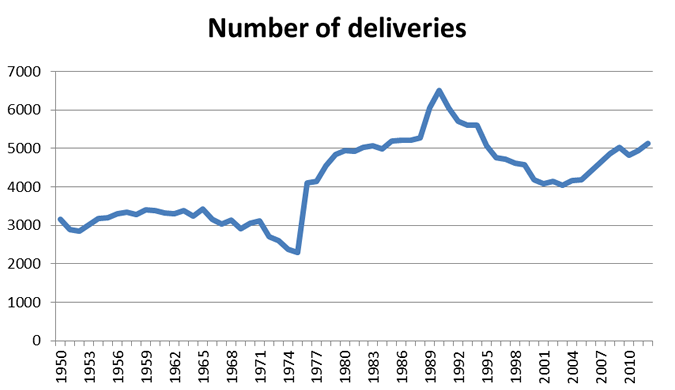
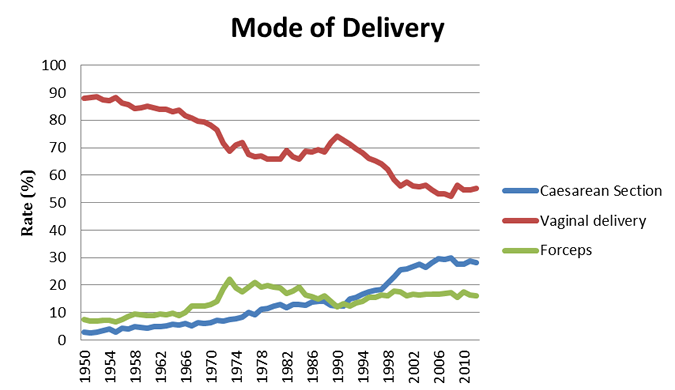
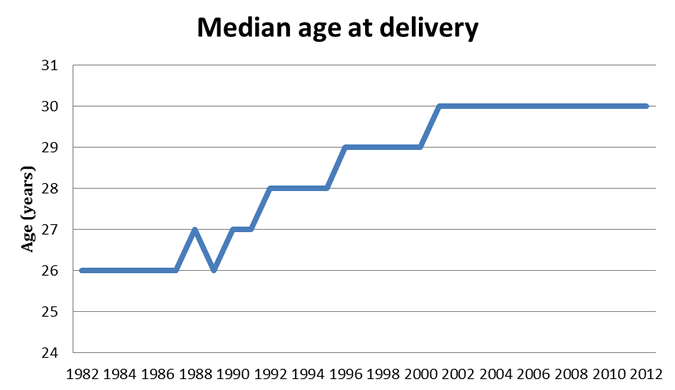
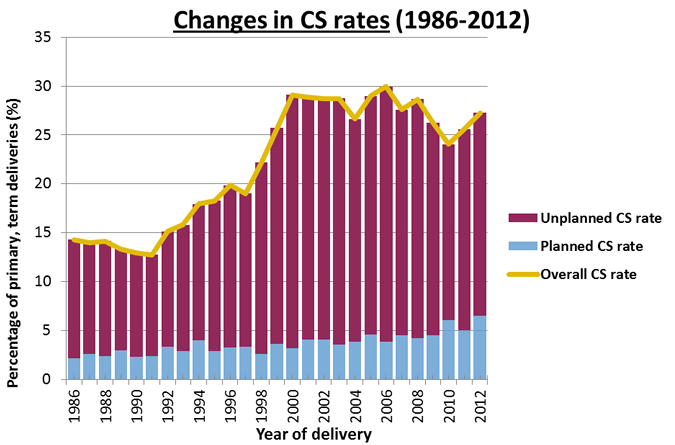
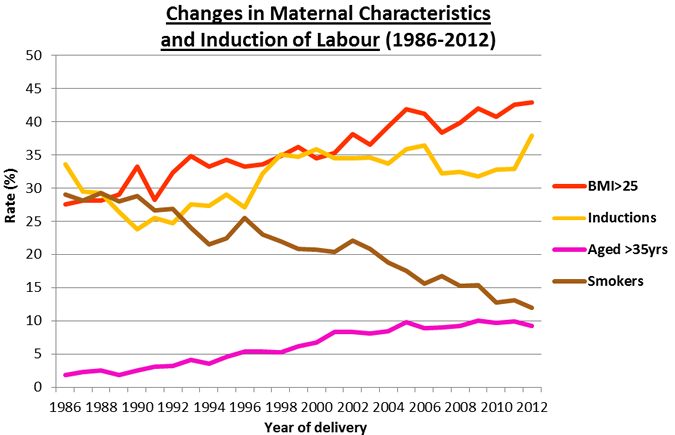
Trend of teenage conceptions and the rate ratio of teenage pregnancy in women who are either in the most deprived Carstairs category or the unskilled occupational social class category (McCall et al., 2014).
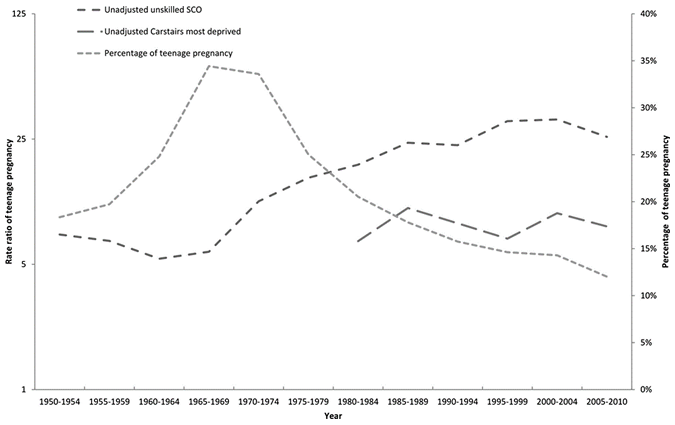
- Steering Committee
-
The AMND Steering Committee was set up to be responsible for the future preservation of the access to the Aberdeen Maternity and Neonatal Databank with data from 1949 onwards. The MRC Medical Sociology Unit collaborated in and has a responsibility for the Databank up to and including data for 1983 only.
The organisations involved in the preparation, processing and access of the data are represented on the Committee as follows:
- Aberdeen Centre for Women's Health Research
- Grampian Data Safe Haven
- Aberdeen Maternity Hospital
Terms of Reference, AMND Steering Committee
- Current Research
-
Dr Sarah Hawco NHS Grampian
In utero risk factors for endometrial cancer
The incidence of endometrial cancer is rapidly rising and is quickly becoming a public health crisis. A significant proportion of cases are driven by excess oestrogen exposure and in particular obesity. In the United Kingdom 20% of the antenatal population are obese, and it is known that this increases morbidity and mortality for both mother and infant. We wish to establish if maternal characteristics and the in-utero environment can increase the fetus’ risk of developing cancer in adulthood, in particular endometrial cancer.
Dr Andrea Woolner University of Aberdeen
Reproductive outcomes after a fully dilated Caesarean
Preterm birth is the leading cause of perinatal morbidity and mortality. Approximately 6% of babies are born preterm in the UK. Late miscarriages (occurring at > 12 weeks gestation) account for 15% of miscarriages in the UK. Having an emergency Caesarean section (CS) when fully dilated has been associated with an increased risk of preterm birth and late miscarriage. We will determine the prevalence of fully dilated CS over time. Thereafter we will look for any association with CS at fully dilated and adverse outcomes in subsequent pregnancies.
Dr Natalie Cameron University of Aberdeen
A composite prediction model for couples planning IVF treatment (COMFORT)
This study will examine the chance of live birth without fertility treatment in couples diagnosed with any form of subfertility at two key time points. The study will aim to improve understanding of the long-term prognosis for subfertile couples and allow them to question the added value of IVF before making critical decisions. This could reduce unnecessary treatment and associated physical and financial for both patients and the NHS.
Professor Steve Turner NHS Grampian
Follow-up of the SEATON birth cohort at 25 years of age
The Study of Eczema and Asthma To Observe the influence of Nutrition (SEATON study) was designed to answer the question "does maternal diet during pregnancy affect asthma outcome in childhood?" We will replicate the methodology we have used in the 15 year follow up to see if the links detected at ages 10 and 15 years are still present.
Dr Andrea Woolner University of Aberdeen
Subsequent pregnancy outcomes after a second trimester pregnancy loss: a cohort study
This study will generate information which is vital to (i) provide women with evidence based knowledge of the impact of second trimester pregnancy loss on future pregnancies and (ii) to develop appropriate antenatal care in subsequent pregnancies after second trimester pregnancy loss.
Dr Mairead Black University of Aberdeen
Effects of in utero exposure to dysglycaemia on growth trajectories of children with Type 1 Diabetes
The aim is to study the growth trajectories in children with type 1 diabetes in NHS Grampian, including height attainment and body mass index trends, and understand how in utero exposure to dysglycaemia (due to maternal impaired glucose tolerance, gestational diabetes, type 1, and type 2 diabetes during pregnancy) can impact on growth trends in children with type 1 diabetes.
Video and podcast
Postal Address
Aberdeen Maternity Neonatal Databank
Aberdeen Centre for Women's Health Research
Institute of Applied Health Sciences
University of Aberdeen
Cornhill Road
Aberdeen
AB25 2ZL
Tel: +44 (0)1224 437288
